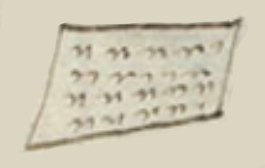mandamiento (CST26)
This painting of the simplex glyph for the term mandamiento (a ruling or an order from the colonial government), shows a rectangular piece of paper with four horizontal rows of double hash marks, where each pair also resembles the letter “n.”
Stephanie Wood
There are no obvious hieroglyphs on these mandamientos, for these were orders that came from the colonial government, which would have been written in Spanish and employing alphabetic text. Still, this representation of writing as alphabetic could have led to an evolution in the author’s thinking about the nature of writing. The Spanish colonizers introduced and instructed Nahua notaries in alphabetic writing–even while hieroglyphic writing would continue through most of the sixteenth century. See some other examples below. For more on the Codex Sierra, see Kevin Terraciano’s study (2021).
Stephanie Wood
1550–1564
Jeff Haskett-Wood
escribir, escritura alfabética, escrituras, mandamientos, papeles, tinta, postes de madera, gobierno, documentos

Stephanie Wood
Códice Sierra-Texupan, plate 26, page dated 1559. Origin: Santa Catalina Texupan, Mixteca Alta, State of Oaxaca. Kevin Terraciano has published an outstanding study of this manuscript (Codex Sierra, 2021), and in his book he refers to alphabetic and “pictorial” writing, not hieroglyphic writing. We are still counting some of the imagery from this source as hieroglyphic writing, but we are also including examples of “iconography” where the images verge on European style illustrations or scenes showing activities. We have this iconography category so that such images can be fruitfully compared with hieroglyphs. Hieroglyphic writing was evolving as a result of the influence of European illustrations, and even alphabetic writing impacted it.
https://bidilaf.buap.mx/objeto.xql?id=48281&busqueda=Texupan&action=search
The Biblioteca Digital Lafragua of the Biblioteca Histórica José María Lafragua in Puebla, Mexico, publishes this Códice Sierra-Texupan, 1550–1564 (62pp., 30.7 x 21.8 cm.), referring to it as being in the “Public Domain.” This image is published here under a Creative Commons license, asking that you cite the Biblioteca Digital Lafragua and this Visual Lexicon of Aztec Hieroglyphs.















